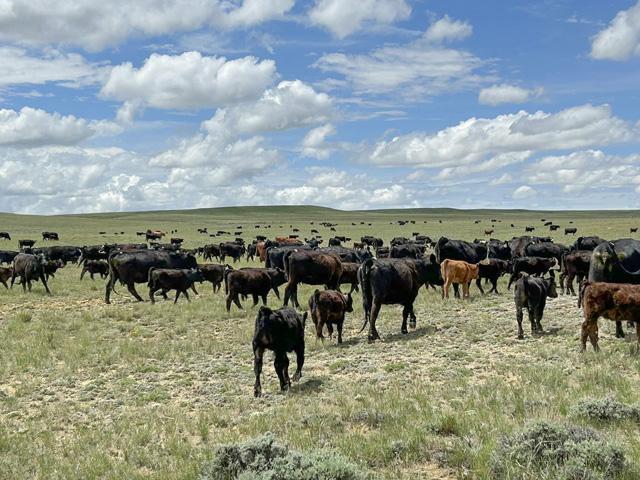Develop Replacement Heifers to Last
BCS, Heifer Development and Economic Efficiency Factor Into Herd Management Practices
OMAHA (DTN) -- When developing replacement heifers, there are different areas where cattle producers should focus their management attention. This includes the importance of understanding and using the body condition score (BCS).
The high-wire balancing act of providing good nutrition with expensive feedstuffs but still maintaining economic efficiency in developing young cows is something producers have to consider. This may mean pushing replacement heifers harder to improve the entire cowherd, according to one expert.
UNDERSTANDING BCS
In a presentation from the Three-State Beef Conference titled "Developing Replacement Heifers for the Future," Kiernan Brandt, a professional services technician for Trans Ova Genetics based in South Dakota, said the importance of BCS and understanding appropriate expectations is something all cattle producers need to be aware of. This is especially true when developing replacement heifers.
Brandt, a former South Dakota State University extension educator, said there are different schools of thought when it comes to BCS and what condition heifers should be in. Some producers like heavy heifers, while others want them somewhat lighter.
He believes ideally heifers should be at a BCS of 5 and at minimum a 4. He prefers them to be a 5 as they go into their first breeding season.
"I know a lot of people don't use this, but I would even say 5.5 would be a magic number for heifers," Brandt said.
BCS is a great tool to use as it has a large effect on how many days there are to estrus cycling. A lower number would certainly narrow a cattle producer's breeding season, Brandt said.
P[L1] D[0x0] M[300x250] OOP[F] ADUNIT[] T[]
He said research bears this out. In one study, heifers with a BCS score of 3 took 89 days to get bred. For a heifer with a BSC of 4, it was only 70 days. A BCS of 5 moved the days down to 60 days; a score of 6 dropped it to 52 days; and for a score of 7, it was only 31 days to estrus cycling.
The pregnancy rate in the study climbed with higher BCS scores -- to a point. Heifers with a BCS of 4 had a pregnancy rate of 50% while a BCS of 5 pushed it up 81%. A BCS of 6 had the pregnancy rate at 98% and at a BCS of 7, the pregnancy rate fell back to 90%.
This scoring is also important following first calving to subsequent fertility, according to Brandt.
Another study showed heifers with a BCS of 4 or less only cycled at a 62% rate and had a pregnancy rate of 61%. Meanwhile, heifers with a BCS of 5 or greater had a cycling rate from 88% to 98% and a 90% pregnancy rate.
Cattle producers who want to utilize BCS would not have to implement drastic changes, nor would they have to be made immediately, Brandt said.
"Just set some goals and stick to them," he said.
CHALLENGE REPLACEMENT HEIFERS
One area where Brandt would like to see change is in developing replacement heifers and determining how hard to push these younger cows. Many producers tend to "baby" their heifers by feeding them with highly nutritious feed.
When these heifers are turned out on grass, however, they tend to be unable to care for themselves as well as experienced cows grazing. These young cows can lose weight, thus taking longer to get bred.
Brandt said one of the heifer development objectives from a large western ranch he has worked with is to produce heifers with "economic efficiency." They developed smaller framed heifers that withstand the adjustment period when they move into the herd.
Reduced size of replacement heifers does not mean reduced breeding. A rising plan of nutrition is emphasized but individual producers will have to decide to allocate so much forage for these heifers, he said.
For many, it is a fine line to determine how much feed will be used to develop heifers, Brandt said.
While at SDSU, he worked on a case study in which they converted heifer development to primarily grazing crop residues with limited supplementation. This method figured out to an average saving of $25/head without supplementation.
Brandt said they challenged heifers to enter the breeding season at a BCS of 5.5 and they were preg-checked at 45 days after artificial insemination. Open heifers were culled. By challenging the heifers, the average cow size stopped increasing, thus reducing maintenance costs across the herd, he said.
The heifers then will calve with a narrow 45-day window along with the cows of the herd, he said. Fertility thus improved in these young cows while maintaining feeding costs.
"Reduced input costs in replacement heifers offers direct and indirect benefits both immediately and over time," he said.
Russ Quinn can be reached at Russ.Quinn@dtn.com
Follow him on social platform X @RussQuinnDTN
(c) Copyright 2024 DTN, LLC. All rights reserved.




